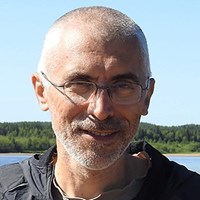Igor Drobyshev

Presentation
My research is a mix of many topics broadly focused on the dynamics of boreal and temperate forests. The studies of forest fires, both historical and modern, clearly dominate my research agenda. Probably, this is due to the fact that my lab, since its establishment in Alnarp in 1997, has always been involved in the fire history research. Initially, the geographical focus has been on Sweden but since approximately 2010 the lab expanded its operations dramatically and now works across the whole boreal zone of the Northern Hemisphere, excluding probably only Alaska. I have been always fascinated by the idea of collecting and using large continental or even global datasets to address research questions connecting climate with ecological processes. To some degree, this interest might have been reinforced by the fact that I started my research career in communist Russia, where the international travel has been a privilege of selected few and to implement such an ambitious agenda would be simply unrealistic. Moving to Sweden and for many years working on both sides of Atlantic gave me the opportunity to pursue actively this vision.
Today the dendrochronological laboratory in Alnarp (www.dendrochronology.se) has its focus on the analyses of patterns and trends in forest fires across circumboreal zone. The lab keeps the leading position in area of dendrochronological reconstruction of fire histories in Europe and over the last years produced a solid volume of high quality research on the subject. Between 2016 and 2020 the lab has been leading international consortium PREREAL tasked with evaluating predictability of regional fire activity across the boreal zone. Dendrochronological methods, i.e. analyses using tree rings, remain our primary research tool, however we make the active use of paleochronological and modelling techniques. Tree-rings is a truly fascinating record to work with, as it allows you to combine your interest in history, ecology, and climate in a rather exiting way.
I also work with seeding ecology, mostly of European beech. Using a combination of tree rings and observational records my lab has published the longest reconstruction of the mast years (i.e. years with very large crops, sometimes called bumper crops) in beech, covering 275 years. We are now working to extend this reconstruction beyond 300 years and to open the door for the analysis of low-frequency variability in masting behavior. Oak ecology and dendroclimatology are among other topics we pursue at Alnarp, connecting to the wealth of research on biodiversity done at the institute.
You will find more detail at www.dendrochronology.se
Selected publications
Eden J, F Krikken, I Drobyshev 2020. An empirical prediction approach for seasonal fire risk in the boreal forests. International Journal of Climatology: 1-13. https://doi.org/10.1002/joc.6363
Drobyshev I, Picq S, Ganivet E, Tremblay F, Bergeron Y. 2019. Decline in the strength of genetic controls on aspen environmental responses from seasonal to century-long phenomena. Ecosphere 10: 1-14. https://doi.org/10.1002/ecs2.2869
Drobyshev I, Widerberg M.K., Andersson M, Wang X, Lindbladh M. 2019. Thinning around old oaks in spruce production forests: current practices show no positive effect on oak growth rates and need fine tuning. Scandinavian Journal of Forest Research, 34: 126-132. https://doi.org/10.1080/02827581.2018.1557247
Giguère-Croteaua C., Boucher E, Bergeron Y, Girardin MP, Drobyshev I, Silvad LCR, Héliee J-F, Garneau M. 2019. North America’s oldest boreal trees are more efficient water users due to increased [CO2], but do not grow faster. PNAS 116: 2749-2754. https://doi.org/10.1073/pnas.1816686116
Drobyshev I, Bergeron Y, Girardin M, Gauthier S, Ols C, Ojal J. 2017. Strong gradients in forest sensitivity to climate change revealed by dynamics of forest fire cycles in post Little Ice Age era. Journal of Geophysical Research - Biogeosciences, 122: 2605-2616. https://doi.org/10.1002/2017JG003826
Drobyshev I, Bergeron Y, de Vernal A, Moberg M, Ali A, Niklasson M 2016. Atlantic SSTs control regime shifts in forest fire activity of Northern Scandinavia. Scientific Reports 6: 1-13. hppts://doi.org/10.1038/srep22532
Drobyshev I, Granström A, Linderholm HW, Bergeron Y, Niklasson M 2015. A 700 year record of large fire years in Northern Scandinavia shows a large variability and increased frequency during 1800s. Journal of Quaternary Science 30: 211-221. https://doi.org/10.1002/jqs.2765
Drobyshev I, Granström A, Linderholm HW, Hellberg E, Bergeron Y, Niklasson M. 2014. Multi-century reconstruction of fire activity in Northern European boreal forest suggests differences in regional fire regimes and their sensitivity to climate. J. Ecol. 102: 738–748. https://doi.org/10.1111/1365-2745.12235
Drobyshev, I., Niklasson, M, Linderholm, H.W. 2012. Fire activity in Sweden: climatic controls and geographical patters in 20th century. Agricultural and Forest Meteorology 154-155: 174-186. https://doi.org/10.1016/j.agrformet.2011.11.002
Drobyshev, I., Niklasson, M., Mazerolle, M.J., Bergeron, Y. 2014. Reconstruction of 253 year long mast record of European beech reveals its association with large scale temperature variability and no long-term trend in mast frequencies. Agricultural and Forest Meteorology. 192-193: 9–17